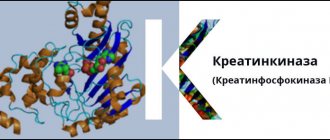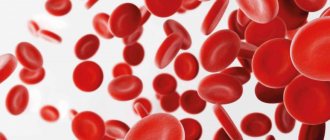Indications for analysis
An increase in amylase concentration is often asymptomatic, but sometimes the following signs are indications for testing:
- pain in the abdominal region or in the right hypochondrium, which becomes intense after eating;
- defecation disorders - mainly diarrhea, but sometimes disorders are accompanied by constipation;
- deterioration in general health - weakness, lethargy, deterioration in performance;
- the presence of altered areas of the pancreas that were identified by palpation, ultrasound or other studies.
The level of amylase in the blood is detected using a biochemical blood test, or less often urine. This is one of many research indicators - according to its indicators, along with lipase and other enzymes, the doctor can judge the state of the patient’s gastrointestinal tract.
Diagnosis of blood for diastasis
To diagnose blood for diastasis, venous blood is taken at the Sensitive LCC in Yeysk. For a more reliable analysis, a few days before blood sampling, you should avoid fatty and fried foods. You should also consult with your doctor about medications that you take regularly - some of them can distort the result of the diastase test. Alcohol should be avoided the day before the test, and smoking should be avoided for several hours.
Blood is donated in the morning on an empty stomach. After taking blood, carbohydrates are added to it, and they look at the speed at which they are broken down in the patient’s blood. The higher the diastase activity, the higher the rate of carbohydrate breakdown.
Normal values
Total amylase by age
- 0-30 days (newborn): 0-6 units/l;
- 31-182 days: 1-17 units/l;
- 183-365 days: 6-44 units/l;
- 1-3 years: 8-79 units/l;
- 4-17 years: 21-110 units/l;
- after 18 years (adults): 26-102 units/l.
Pancreatic amylase by age
- 0-24 months: 0-20 units/l;
- 2-18 years: 9-35 units/l;
- after 18 years: 11-54 units/l.
(Please note that reference intervals may vary between laboratories, so for blood and urine tests please refer to the intervals listed on the report).
Increased amylase in women and children
In women and men, adults and children, the reasons for increased amylase are usually the same, but in the fairer sex, a similar condition can be observed with ectopic pregnancy, as well as certain hormonal disorders caused by taking oral contraceptives or other drugs containing hormones.
Sometimes an increase in amylase concentration is characteristic of the period after termination of pregnancy and cancer of the reproductive organs.
A decrease in amylase levels can be just as serious a symptom as its increase, and indicate problems with the liver or gastrointestinal tract.
In childhood, an increase in the amount of enzyme can be observed in gastrointestinal diseases, as well as hereditary pathologies associated with impaired enzyme production. In any case, a child who experiences a similar phenomenon needs a comprehensive study, especially if it is accompanied by additional symptoms.
Blood amylase level
Since the pancreas is a mixed secretion gland (it secretes hormones and enzymes both into the intestinal lumen and into the blood), the amylase produced in it is usually distinguished from general alpha-amylase and called pancreatic amylase. Accordingly, in a biochemical blood test (or urine, which is also used to determine the level of amylase in the body), two indicators of amylase are distinguished: alpha-amylase and pancreatic amylase.
Alpha amylase
For alpha-amylase (representing the total amount of all amylase in the body), the following values are considered normal: *
- children under 2 years old: 5 - 65 U/l;
- 2 years – 70 years: 25 – 125 U/l;
- over 70 years old: 20 - 160 U/l.
*according to independent laboratory Invitro
Pancreatic amylase
Alpha-amylase includes pancreatic amylase, the amount of which is also measured. The normal amount of pancreatic amylase is considered*:
- children under 6 months: <8 U/ml; children 6 - 12 months: <23>
- all over 1 year: <50 U/ml.
*according to independent laboratory Invitro
- Amylase. Normal blood levels in women, men, children by age, table. What does it mean increased, decreased, treatment
Reasons for increased amylase
When detecting blood amylase levels, the norm in adults depends on the reference values of a particular laboratory, and is usually up to 31 U/L in women and up to 41 U/L in men.
An increase in numbers by a factor of two or more is considered a dangerous sign - it means that the human digestive system is working abnormally, which can lead to serious consequences.
A slight increase in amylase concentration may be transient and not indicate serious disorders.
If the enzyme content is elevated, it means that the pancreas is working too actively, secreting substances that immediately enter the blood. This becomes possible for a number of reasons:
- excess production of pancreatic juice - a special liquid that is produced in the pancreas and is actively involved in the digestive processes;
- obstacles appear that interfere with the movement of juice through the ducts of the organ;
- Inflammatory processes occur in the tissues of the pancreas or neighboring organs - consequences of tissue destruction, the action of pathogenic microorganisms, necrosis, and mechanical injuries.
Each of the above conditions can pose a threat to human health or even life, and in some cases requires immediate medical attention.
Most common diseases
There are a number of diseases in which patients most often experience an increase in amylase concentration.
| Disease | Features and symptoms |
| Acute pancreatitis | Inflammation that develops in the tissues of the pancreas with lightning speed. The organ begins to work in increased mode, as a result of which tissue is damaged by its own enzymes. Signs: severe girdle pain, uncontrollable vomiting, bloating, flatulence |
| Chronic pancreatitis | In the chronic course of the disease, changes in tissues occur gradually, often without pronounced symptoms. The first signs of the condition are discomfort that occurs after eating - heaviness and nagging pain in the right hypochondrium, belching, hiccups, changes in appetite |
| Neoplasms in different parts of the organ | Most often, benign and malignant tumors are localized in the head of the pancreas, but they can also affect other parts of it. Manifestations of cancer depend on the characteristics and size of the tumor, include digestive disorders, pain of varying intensity, anemia and constant weakness |
| Cholelithiasis | During a pathological process, stones form in the gallbladder and its ducts, which obstruct the movement of bile. The first symptoms are pain and discomfort on the right side under the ribs, a feeling of bitterness in the mouth, heartburn, fever, discoloration of stool |
| Diabetes | A systemic metabolic disorder that leads to disorders of almost all organs and systems, including the digestive system. Amylase and other enzymes in the patient's body are consumed incorrectly, which leads to an increase in their concentration. Signs include constant thirst, loss of appetite, sweating, decreased urine output, yellowing of the skin |
| Peritonitis | Inflammatory processes in the tissues of the peritoneum, which cause a serious condition requiring immediate surgical intervention. With peritonitis, the pancreas is irritated, which increases its activity. It usually manifests itself acutely, with severe abdominal pain, nausea and vomiting, fever, loss of consciousness |
| Mumps | A disease common in children and known as mumps or mumps. It is caused by pathogenic microorganisms, and its manifestations include enlargement of the salivary glands, which are also involved in the production of amylase. Symptoms of mumps resemble a common cold; characteristic swelling appears near the child’s ears, which is considered a specific sign of the disease |
| Kidney failure | A pathological condition of the urinary system, which is characterized by impaired renal function - they cannot produce and excrete urine in a timely manner. Unlike other diseases, with renal failure there is not an increase in amylase production, but its retention in the body |
A short-term increase in amylase in the absence of accompanying symptoms may not indicate disorders in the body. In such cases, the level of the enzyme is determined dynamically - if amylase is elevated in an adult, this means that he requires a more accurate comprehensive study.
Other reasons
Other reasons that can cause an increase in amylase concentration in the blood include:
- mechanical injuries of the abdominal cavity;
- aneurysms;
- tumor processes of the genitourinary system;
- taking medications;
- gallbladder pathology;
- frequent stress and psycho-emotional tension;
- intestinal obstruction;
- herpes virus in the body;
- postoperative conditions (abdominal surgery).
Sometimes an increase in amylase levels is observed during nutritional disorders - the predominance of fatty, smoked, salty and pickled foods,
What is this enzyme and what is it for?
Amylase is a digestive enzyme that helps break down carbohydrates. However, for proper operation, its level must be within normal limits.
Amylase begins to be produced when the body consumes starchy foods. These are potatoes, rice, baked goods, etc. There are alpha, beta and gamma types.
Urine and blood are tested to determine amylase levels, and tests are performed on the same day to eliminate errors.
Blood is taken from a vein early in the morning on an empty stomach. When a person seeks medical help, tests are carried out at any time, but in such cases it is necessary to take into account the time of day and the food that the patient eats.
How to normalize an indicator
The production of amylase is an independent process in the body. In case of significant excess of its norm, it is necessary to carry out appropriate treatment, since this phenomenon negatively affects the patient’s condition and can be life-threatening.
Only an experienced specialist should prescribe the necessary therapy. Self-medication can not only be ineffective, but also lead to disastrous consequences.
Treatment measures can only be determined after research and an accurate diagnosis have been made. They should be aimed at eliminating the cause of the pathological condition.
To get rid of the underlying disease, a prescription for medications is written.
Treatment is prescribed individually, taking into account the age category, stage of the disease and the general condition of the patient.
Diet
For diabetes, pancreatitis, digestive tract disorders and other pathologies, you must follow a special diet. It is important to adjust your diet to reduce amylase levels.
The diet consists of the following elements:
- It is necessary to control the amount of protein entering the body.
- It is necessary to limit or exclude carbohydrates and fats from the diet as much as possible.
- It is important to avoid fried, spicy, salty, smoked, sour and alcoholic drinks. These products irritate the gastric mucosa.
- It is necessary to limit the intake of fiber into the body.
- It is not recommended to use marinades.
- You cannot eat onions, garlic and radishes.
- He should include in his diet a lot of fresh fruits and vegetables, natural juices and cereals.
- Fish and meat should be lean.
Food should be consumed in small portions 5-6 times a day.
Improper nutrition has a bad effect on the condition and function of the pancreas; following a diet can shorten the treatment period.
Symptoms
Excessive levels of this enzyme are diagnosed in diseases of the pancreas and other internal organs and require therapy. The disease is accompanied by symptoms:
- Pain in the hypochondrium and epigastrium on the right. This symptom worsens after eating. After defecation, the pain goes away.
- Impaired passage of stool, diarrhea is more common, stool is released in small quantities. The reason is a violation of the contractile function of the intestine.
- Apathy, drowsiness.
- Reduced performance.
- Deterioration in sleep quality does not bring increased strength.
- Attractive pain in the lower abdomen during pregnancy.
A patient's visit to a doctor with the above symptoms often leads to hospitalization. In this case, it is necessary to identify the root cause of the illness.
Possible consequences of violation
An increase in amylase concentration in the blood, even if it is not accompanied by unpleasant symptoms, requires immediate correction. This disorder in itself is not dangerous, but its causes can cause serious harm to health and lead to complications. Acute and chronic pancreatitis cause death of pancreatic tissue, which can lead to disability and even death. Gallstone disease, diabetes mellitus and other pathologies are also dangerous for the body and require consultation with a doctor.
A slight increase in enzyme levels usually does not indicate serious illness, but if the levels increase by 2-3 times, you should seek medical help as soon as possible. This is especially true in cases where the pathological condition is accompanied by pain or other symptoms.
With a correct diagnosis, timely treatment, compliance with medical recommendations and preventive measures, amylase levels can be quickly normalized and prevented from increasing in the future.









